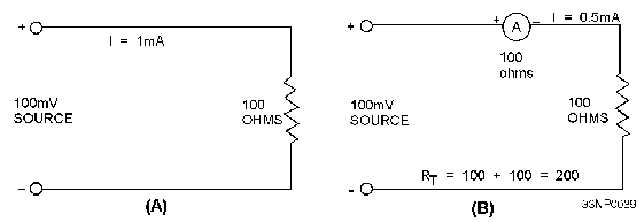3-12
circuit operation and changes the amount of current flow, the reading you obtain will be in error. An
example of this is shown in figure 3-7.
Figure 3-7.—Ammeter loading effect.
Q-14. What condition exists when the insertion of a meter into a circuit changes the operation of the
circuit?
In view A of figure 3-7, the circuit to be tested has an applied voltage of 100 millivolts and a
resistance of 100 ohms. The current normally flowing in this circuit is 1 milliampere. In view B, an
ammeter that requires 1 milliampere for full-scale deflection and that has an internal resistance of 100
ohms has been inserted. Since 1 milliampere of current flow is shown in view A, you might naturally
assume that with the meter inserted into the circuit, a full-scale deflection will occur. You might also
assume that the 1 milliampere of circuit current will be measured. However, neither of these assumptions
is correct. With the ammeter inserted into the circuit, as shown in view B, the total resistance of the circuit
is 200 ohms. With an applied voltage of 100 millivolts, applying Ohm’s law shows the actual current
(Icircuit) to be 0.5 milliampere.
Since the meter reads 0.5 milliampere instead of the normal value of current, the meter reveals that a
definite loading effect has taken place. In cases such as this, the use of ammeters, which have a lower
internal resistance and a better current sensitivity, is desirable.
DC VOLTMETER
Up to this point, we have been discussing the 100-microampere D’Arsonval movement and its use as
an ammeter. However, it can also be used to measure voltage if a MULTIPLIER (high resistance) is
placed in series with the moving coil of the meter. For low-voltage instruments, this resistance is
physically mounted inside the meter case with the D’Arsonval movement. The series resistance is
constructed of a wire-wound resistance that has a low temperature coefficient wound on either a spool or



